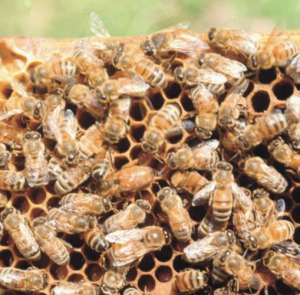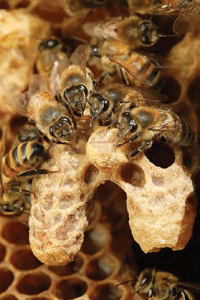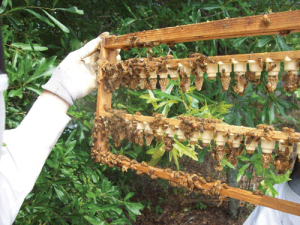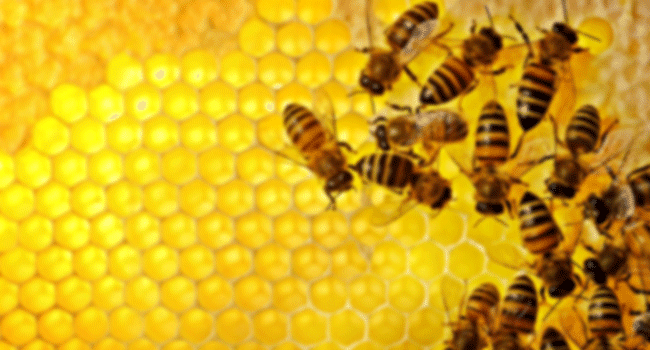QUEEN PHEROMONE
Queen pheromone is complex and is produced from multiple glands.
Honey bee queens produce a sophisticated array of chemical signals (pheromones) that influence both the behavior and physiology of their nest mates (Beggs et al. 2007). This pheromone blend is complex and is produced from multiple glands including mandibular glands, tergal glands and the Dufour’s gland (Grozinger 2015). In the colony, division of labor and productivity are carefully regulated by the wide array of glandular pheromones produced by the queen (Kocher and Grozinger 2011; Le Conte and Hefetz 2008; Slessor et al. 2005). These pheromones regulate many aspects of colony organization.
Queens produce pheromones that function in both releaser and primer roles such as attracting a retinue of workers around her, attracting drones on mating flights, preventing workers from reproducing at the individual (worker egg-laying) and colony (swarming) level, and regulating several other aspects of colony functioning.
In terms of reproduction, queen mandibular pheromone (QMP) inhibits the production of new queens (Melathopoulos et al. 1996; Pettis et al. 1997; Pettis et al. 1995b), suppresses the activation of worker ovaries (Butler and Fairey 1963; Hoover et al. 2003), and serves as a sex attractant for drones during mating (Brockmann et al. 2006: Gary 1962). In workers, QMP stimulates pollen and nectar foraging (Higo et al. 1992; Pankiw et al. 1998; Pettis et al. 1995a), delays the age-of-onset for foraging (Pankiw et al. 1998) and lowers juvenile hormone titers (Pankiw et al. 1998). Furthermore, QMP elicits a “retinue response,” a behavioral suite in which workers surround the queen, antennate, groom and lick her, all while collecting QMP pheromone to share with other nestmates (Slessor et al. 1988; Pankiw et al. 1994; Pankiw et al. 1995; Kaminski et al. 1990). Dissemination of QMP among workers enables nestmates to recognize the queen’s presence without the need for all workers to come in direct contact with the queen (Seeley 1979).
 Kocher et al. (2009) investigated the role of mating and reproductive state on queen pheromone production and worker responses. Virgin queens, naturally mated queens, and queens instrumentally inseminated with either semen or saline were collected two days after mating or insemination. Naturally mated queens had the most activated ovaries and the most distinct chemical profile in their mandibular glands. Instrumentally inseminated queens were intermediate between virgins and naturally mated queens for both ovary activation and chemical profiles. There were no significant differences between semen and saline-inseminated queens. Workers were preferentially attracted to the mandibular gland extracts from queens with significantly more activated ovaries. These studies suggest that the queen pheromone blend is modulated by the reproductive status of the queens, and workers can detect these subtle differences and are more responsive to queens with higher reproductive potential. Furthermore, it appears as if insemination substance does not strongly affect physiological characteristics of honey bee queens two days after insemination, suggesting that the insemination process or volume is responsible for stimulating these early postmating changes in honey bee queens.
Kocher et al. (2009) investigated the role of mating and reproductive state on queen pheromone production and worker responses. Virgin queens, naturally mated queens, and queens instrumentally inseminated with either semen or saline were collected two days after mating or insemination. Naturally mated queens had the most activated ovaries and the most distinct chemical profile in their mandibular glands. Instrumentally inseminated queens were intermediate between virgins and naturally mated queens for both ovary activation and chemical profiles. There were no significant differences between semen and saline-inseminated queens. Workers were preferentially attracted to the mandibular gland extracts from queens with significantly more activated ovaries. These studies suggest that the queen pheromone blend is modulated by the reproductive status of the queens, and workers can detect these subtle differences and are more responsive to queens with higher reproductive potential. Furthermore, it appears as if insemination substance does not strongly affect physiological characteristics of honey bee queens two days after insemination, suggesting that the insemination process or volume is responsible for stimulating these early postmating changes in honey bee queens.
Niño et al. (2013) examined the long-term impact of different factors involved during queen insemination on the chemical composition of the mandibular and Dufour’s glands, two of the major sources of queen pheromone. Their results demonstrate that carbon dioxide (an anesthetic used in instrumental insemination), physical manipulation of genital tract (presumably mimicking the act of copulation), insemination substance (saline vs. semen), and insemination volume (1 vs. 8 ml) all have long-term effects on mandibular gland chemical profiles. In contrast, Dufour’s gland chemical profiles were changed only upon insemination and were not influenced by exposure to carbon dioxide, manipulation, insemination substance or volume. These results suggest that the chemical contents of these two glands are regulated by different neuro-physiological mechanisms. Furthermore, workers responded differently to the different mandibular gland extracts in a choice assay. Although these studies must be validated in naturally mated queens of varying mating quality, their results suggest that while the chemical composition of Dufour’s gland is associated with mating status, that of the mandibular glands is associated with both mating status and insemination success. Thus the queen appears to be signaling both status and reproductive quality to the workers, which may impact worker behavior and physiology as well as social organization and productivity of the colony.
Workers were significantly more attracted to high-quality queens than to low-quality queens.
Rangel et al. (2016) investigated differences in the chemical composition of the mandibular glands and attractivenss to workers of “high-quality” queens (i.e., raised from fist instar larvae; more queen-like) and “low-quality” queens (i.e., raised from third instar worker larvae; more worker-like). They characterized the chemical profiles of the mandibular glands of high quality queens and low-quality queens using GCMS and used the worker retinue response as a measure of the attractiveness to workers of high-quality queens vs. low-quality queens. They found that queen quality affected the chemical profiles of mandibular gland contents differently across years, showing significant differences in the production of the queen mandibular pheromone (QMP) components HVA and 9-HDA in 2010, but no significant differences of any glandular compound in 2012. They also found that workers were significantly more attracted to high-quality queens than to low-quality queens in 2012, possibly because of increased attractiveness of their mandibular gland chemical profiles. Rangel et al. (2016) found that the age at which honey bee larvae enter the “queen-specific” developmental pathway influences the chemical composition of queen mandibular glands and worker behavior. However, these changes are not consistent across years, suggesting that other external factors may play important roles in modulating queen quality.
 Queen honey bees are attractive to their workers, due partially to the pheromonal bouquet they secrete. Queen mandibular gland pheromone is a powerful attractant to worker honey bees but it is not solely responsible for eliciting retinue behavior. The attractiveness of virgin queen tergal gland secretions and queen mandibular pheromone to worker honey bees was tested using a retinue bioassay. The number of workers attending the treated pseudoqueen lures was videorecorded in order to allow for the quantification of attractiveness. Queen mandibular gland secretions were more attractive than tergal gland secretions, and both queen tergal gland secretions and mandibular gland secretions were significantly more attractive than the control treatment. This laboratory bioassay indicates that queen tergal gland secretions have a releaser effect that evokes retinue behavior from worker honey bees (Wossler and Crewe 1999).
Queen honey bees are attractive to their workers, due partially to the pheromonal bouquet they secrete. Queen mandibular gland pheromone is a powerful attractant to worker honey bees but it is not solely responsible for eliciting retinue behavior. The attractiveness of virgin queen tergal gland secretions and queen mandibular pheromone to worker honey bees was tested using a retinue bioassay. The number of workers attending the treated pseudoqueen lures was videorecorded in order to allow for the quantification of attractiveness. Queen mandibular gland secretions were more attractive than tergal gland secretions, and both queen tergal gland secretions and mandibular gland secretions were significantly more attractive than the control treatment. This laboratory bioassay indicates that queen tergal gland secretions have a releaser effect that evokes retinue behavior from worker honey bees (Wossler and Crewe 1999).
In honey bee queens, the production of tergal gland alkenes was found to be stimulated by natural mating and not by instrumental insemination (Smith et al. 1993). Carbon dioxide, physical manipulation of the sting chamber and vagina, presence of sperm in the spermatheca, egg production and chemicals transferred via drone semen were demonstrated to not initiate the synthesis of the tergal gland alkenes. The compounds probably do not function as sex pheromones. However, the circumstances and timing of the initiation of production of the tergal gland alkenes strongly suggests a communication role for the compounds within the hive.
Honey bee workers develop from fertilized eggs, but those reared in a queenless colony develop into ‘rebel’ workers, which are more queen-like than typical workers. Rebels develop after an old queen leaves with a swarm and before a new queen hatches. Woyciechowski et al. (2016) hypothesized that larval food lacking queen mandibular pheromones trigger the rebel phenotype. Larvae reared under queenright or queenless conditions were additionally fed with water or a drop of macerated queen mandibular glands. After following development of the bees and subjecting them to dissection, they found that those reared with a queen or fed the macerated glands under queenless conditions developed into typical workers. Only those workers reared without a queen and without macerated glands added to their food developed into rebels; these rebels had more ovarioles, smaller hypopharyngeal glands, and larger mandibular and Dufour’s glands than did typical workers. This is the first evidence that larval perception of the presence or absence of queen pheromones causes an alternative developmental strategy.
 Pheromones produced by the queen are responsible for determining the reproductive state of the workers. Until recently the proximate molecular mechanisms underlying facultative worker sterility were unidentified. Studies into worker oogenesis in the honey bee have indicated that programmed cell death is central to the regulation of oogenesis. Ronai et al. (2016) investigated how queen pheromone, age of the worker and ovary state affect both programmed cell death and cell number in worker ovaries. They described a novel method to simultaneously measure programmed cell death (caspase activity) and live cell number (estimated from the amount of adenosine triphosphate) in an insect tissue. Workers exposed to queen pheromone have higher levels of caspase activity in the ovary than those not exposed. Their results suggest that queen pheromone triggers programmed cell death at the mid-oogenesis checkpoint causing the abortion of worker oocytes and reproductive inhibition of the worker caste. Nonetheless, high caspase activity is present in activated ovaries from workers not exposed to queen pheromone. This caspase activity is most likely to be from the nurse cells undergoing programmed cell death, in late oogenesis, for normal oocyte development. Their study shows that the social environment of an organism can influence programmed cell death within a tissue.
Pheromones produced by the queen are responsible for determining the reproductive state of the workers. Until recently the proximate molecular mechanisms underlying facultative worker sterility were unidentified. Studies into worker oogenesis in the honey bee have indicated that programmed cell death is central to the regulation of oogenesis. Ronai et al. (2016) investigated how queen pheromone, age of the worker and ovary state affect both programmed cell death and cell number in worker ovaries. They described a novel method to simultaneously measure programmed cell death (caspase activity) and live cell number (estimated from the amount of adenosine triphosphate) in an insect tissue. Workers exposed to queen pheromone have higher levels of caspase activity in the ovary than those not exposed. Their results suggest that queen pheromone triggers programmed cell death at the mid-oogenesis checkpoint causing the abortion of worker oocytes and reproductive inhibition of the worker caste. Nonetheless, high caspase activity is present in activated ovaries from workers not exposed to queen pheromone. This caspase activity is most likely to be from the nurse cells undergoing programmed cell death, in late oogenesis, for normal oocyte development. Their study shows that the social environment of an organism can influence programmed cell death within a tissue.
Queen rearing is suppressed in honey bees by pheromones, particularly the queen’s mandibular gland pheromone. Pettis et al. (1995b) compared this pheromonally-based inhibition between temperate and tropically-evolved honey bees. Colonies of European and Africanized bees were exposed to synthetic queen mandibular gland pheromone (QMP) for ten days following removal of resident queens, and their queen rearing responses were examined. Queen rearing was suppressed similarly in both European and Africanized honey bees with the addition of synthetic QMP, indicating that QMP acts on workers of both races in a comparable fashion. QMP completely suppressed queen cell production for two days, but by day six, cells containing queen larvae were present in all treated colonies, indicating that other signals play a role in the suppression of queen rearing. In queenless control colonies not treated with QMP, Africanized bees reared 30% fewer queens than Europeans, possibly due to racial differences in response to feedback from developing queens and/or their cells. Queens development rate was faster in Africanized colonies, or they selected older larvae to initiate cells, as only 1% of queen cells were unsealed after 10 days compared with 12% unsealed cells in European colonies (Pettis et al. 1995b).
References
Beggs, K.T., K.A. Glendining, N.M. Marechal, V. Vergoz, I. Nakamura, K.N. Slessor and A.R. Mercer 2007. Queen pheromone modulates brain dopamine function in worker honey bees. Proc. Nat. Acad. Sci. 104: 2460-2464.
Brockmann, A., D. Dietz, J. Spaethe and J. Tautz 2006. Beyond 9-ODA: sex pheromone communication in the European honey bee Apis mellifera L. J. Chem. Ecol. 32: 657-667.
Butler, C. and E. Fairey 1963. The role of the queen in preventing oogenesis in worker honeybees. J. Apic. Res. 2: 14-18.
Gary, N.E. 1992. Activities and behavior of honey bees. In: The Hive And The Honey Bee (Ed. J.M. Graham), Dadant and Sons, Hamilton, IL, pp. 269-372.
Grozinger, C.M. 2015. Honey bee pheromones. In: The Hive And The Honey Bee (Ed. J.M. Graham), Dadant And Sons, Hamilton, IL, pp. 311-342.
Higo, H.A., S.J. Colley, M.L. Winston and K.N. Slessor 1992. Effects of honey bee (Apis mellifera L.) queen mandibular gland pheromone on foraging and brood rearing. Can. Entomol. 124: 409-418.
Hoover, S.E., C.I. Keeling, M.L. Winston and K.N. Slessor 2003. The effect of queen pheromones on worker honey bee ovary development. Naturwissenschaften 90: 477-480.
Kaminski, L.A., K.N. Slessor, M.L. Winston, N.W. Hay and J.H. Borden 1990. Honey bee response to queen mandibular pheromone in laboratory bioassays. J. Chem. Ecol. 16: 841-850.
Kocher, S.D. and C.M. Grozinger 2011. Cooperation, conflict, and the evolution of queen pheromones. J. Chem. Ecol. 37: 1263-1275.
Kocher, S.D., F.-J. Richard, D.R. Tarpy and C.M. Grozinger 2009. Queen reproductive state modulates pheromone production and queen-worker interactions in honeybees. Behav. Ecol. 20: 1007-1014.
Le Conte, Y. and A. Hefetz 2008. Primer pheromones in social hymenoptera. Annu. Rev. Entomol. 53: 523-542.
Melathopoulos, A., M. Winston, J. Pettis and T. Pankiw 1996. Effect of queen mandibular pheromone on initiation and maintenance of queen cells in the honey bee (Apis mellifera L.) Can. Entomol. 128: 263-272.
Niño, E.L., O. Malka, A. Hefetz, D.R. Tarpy and C.M. Grozinger 2013. Chemical profiles of two pheromone glands are differentially regulated by distinct mating factors in honey bee queens (Apis mellifera L.). PLoS ONE 8(11): e78637. doi:10.1371/journal.pone.0078637
Pankiw, T., M. Winston and K. Slessor 1994. Variation in worker response to honey bee (Apis mellifera L.) queen mandibular pheromone (Hymenoptera: Apidae). J. Insect Behav. 7: 1-15.
Pankiw, T., M. Winston and K. Slessor 1995. Queen attendance behavior of worker honey bees (Apis mellifera L.) that are high and low responding to queen mandibular pheromone. Insect. Soc. 42: 371-378.
Pankiw, T., Z. Huang, M. Winston and G. Robinson 1998. Queen mandibular gland pheromone influences worker honey bee (Apis mellifera L.) foraging ontogeny and juvenile hormone titers. J. Insect Physiol. 44: 685-692.
Pettis, J., M. Winston and K. Slessor 1995a. Behavior of queen and worker honey bees (Hymenoptera: Apidae) in response to exogenous queen mandibular gland pheromone. Ann. Entomol. Soc. Am. 88: 580-588.
Pettis, J., M. Winston and A. Collins 1995b. Suppression of queen rearing in European and Africanized honey bees Apis mellifera L. by synthetic queen mandibular gland pheromone. Insect. Soc. 42: 113-121.
Pettis, J., H. Higo, T. Pankiw and M. Winston 1997. Queen rearing suppression in the honey bee-evidence for a fecundity signal. Insect. Soc. 44: 311-322.
Rangel, J., K. Böröczky, C. Schal and D.R. Tarpy 2016. Honey bee (Apis mellifera) queen reproductive potential affects queen mandibular gland pheromone composition and worker retinue response. PLoS ONE 11(6): e0156027. doi: 10.1371/journal.pone.0156027 (PDF)
Ronai, I., B.P. Oldroyd and V. Vergoz 2016. Queen pheromone regulates programmed cell death in the honey bee worker ovary. Insect Mol. Biol. 25: 646-652.
Seeley, T.D. 1979. Queen substance dispersal by messenger workers in honey bee colonies. Behav. Ecol. Sociobiol. 5: 391-415.
Slessor, K.N., L.-A. Kaminski, G. King, J.H. Borden and M.L. Winston 1988. Semiochemical basis of the retinue response to queen honey bees. Nature 332: 354-356.
Slessor, K.N., M.L. Winston and Y. Le Conte 2005. Pheromone communication in the honeybee (Apis mellifera L.). J. Chem. Ecol. 31: 2731-2745.
Smith, R.-K., M. Spivak, O.R. Taylor, Jr., C. Bennett and M.L. Smith 1993. Maturation of tergal gland alkene profiles in European honey bee queens, Apis mellifera L. J. Chem. Ecol. 19: 133-142.
Wossler, T.C. and R.M. Crewe 1999. The releaser effects of the tergal gland secretion of queen honeybees (Apis mellifera) J. Insect Behav. 12: 343-351.
Woyciechowski, M., K. Kuszewska, J. Pitorak and J. Kierat 2016. Honeybee worker larvae perceive queen pheromones in their food. Apidologie doi: 10.1007/s13592-016-0459-1
Clarence Collison is an Emeritus Professor of Entomology and Department Head Emeritus of Entomology and Plant Pathology at Mississippi State University, Mississippi State, MS.










